Puteh Tails (FanTail)
Nowadays it is very rare to see a Fantail Puteh...
A bird's tail consists of a tailbone, a set of flight feathers, and a
layer of covering feathers at the base of the tail. The tail serves a
number of aerodynamic functions.
The number the tail feathers by counting outward both right and left
from the central most pair of tail feathers. For instance, both the
right central tail feather is number one and the left central feather is
number one. We count outward to the outer right and left tail feather
respectively. For example, the outer right and left tail feather of most
songbirds is number six, meaning that songbirds typically have six
pairs of tail feathers.
Without their tail feathers, flying
would be a pretty difficult chore. It acts as a rudder to provide
stability and control steering of direction of a bird’s flight, and it
also helps the bird land, take off, and change altitude. When not
flying, many birds use their tail feathers as supports when on the
ground or climbing the sides of trees.
Join Mata Puteh Community On FaceBook: http://www.facebook.com/sgmataputeh
Thursday, July 4, 2013
Wednesday, July 3, 2013
Gather some fruits for Puteh Birds
 Fruits are an integral part in food for Puteh, it replenishing the nutrients for the birds. Even wild birds are also often looking for fruits to eat. The following are some fruits that Puteh enjoyed.
Fruits are an integral part in food for Puteh, it replenishing the nutrients for the birds. Even wild birds are also often looking for fruits to eat. The following are some fruits that Puteh enjoyed.Puteh hobbyist knows of any other fruits, please add-on, looking forward for suggestions to share and improve.
This is my personal opinion, taken from reality whom have been feeding Puteh birds. These fruits would not do any harm to Puteh bird.
Gather some fruits for Puteh Birds
Apples/Bananas/Papayas: Dry and not dirtying the cage, very suitable for birds.
Oranges: During hot weather, cooling for birds, especially to detoxify.
Cooling effects
Cucumber/Luffa/ water chestnut/: Helping Puteh to grow excellent conditioned silky plumage (Especially during molting).
Tomatoes/Carrot: Help the Puteh build up brilliant beautiful colours.
Join Mata Puteh Community On FaceBook: http://www.facebook.com/sgmataputeh
Enjoy your hobby, cheers!
Tuesday, July 2, 2013
Improve Mata Puteh Performance
 Taking care of your Mata Puteh and improve its performance.
Taking care of your Mata Puteh and improve its performance.When a bird is subject to sudden change of diet (or inconsistency) you will notice some of this:
a) Going into molt even if it is not time yet for molting.
b) Sudden drop in form
c) Watery droppings.
Taming Puteh, expose him more on human interactive and bath him more often. Example: At least 1 a day, as time goes by he will be settle down quite easily. Meanwhile, get yourself a bath cage for Finch/Mata Puteh; transfer your Mata Puteh into bath cage whenever you do the maintenance work Example: Top up water/food/cleaning to prevent your bird from escape and suffer serious head injury.
A bird depends very much on its feathers to be able to fly AND more often than not, its plumage will help determine whether it will get a mate. Any bird - whether a Jambul or Puteh or a Hornbill - will spend lots of time preening themselves to ensure their most precious possession, their feathers, are in tip top condition.
During molting period, I even bathe the bird with rice water. Rice water will helps the plumage of birds to grow excellent brilliant condition. It smoothen the feathers when it grows thus giving the bird with finest beautiful plumage.
If you have observed birds in the wild, the ones with poor plumage condition will almost never get a mate and more likely to be chased away by other male birds whose plumage are in excellent brilliant condition.
The moral is: - the more often you bathe the Puteh (or any bird) you can be sure it will be in top form.
Join Mata Puteh Community On FaceBook: http://www.facebook.com/sgmataputeh
Enjoy your hobby, cheers!
Signs Of Puteh Molting
 Signs Of Puteh Molting
Signs Of Puteh MoltingWhen a Puteh is subject to sudden change of diet/ inconsistency it will go into molt even if it is not the time yet for molting. Older birds need more fruit, they tend to develop too much “fire” with dry food and start to molt.
You will notice some of these:
a) Puteh becomes fluffy or 'fat' (sudden drop in form).
b) Small pieces of feathers dropping (plucking feathers every now and then).
c) Growing of white “hairs” (especially over the top part from neck upwards).
Maybe you should have set up its cage with all the niceties of "Puteh" life like; a cut of papaya, water chestnut or luffa during this molting period. Fresh water, dry food and cover its cage fully with a piece of cloth completely. Slowly you may remove the cloth raising it higher every 3-4 days till it finished molting.
During molting period, bathe the Puteh twice a day. (Rice water will help up the molting process). The Puteh will grow excellent brilliant conditioned beautiful plumage.
Join Mata Puteh Community On FaceBook: http://www.facebook.com/sgmataputeh
Puteh Cough
Puteh Cough
 Went to bird shop today with my friend to see Puteh doctor, his Puteh having sore throat and cough. "Consultation" fee and medicine dropping cause $10.
Went to bird shop today with my friend to see Puteh doctor, his Puteh having sore throat and cough. "Consultation" fee and medicine dropping cause $10.
 Went to bird shop today with my friend to see Puteh doctor, his Puteh having sore throat and cough. "Consultation" fee and medicine dropping cause $10.
Went to bird shop today with my friend to see Puteh doctor, his Puteh having sore throat and cough. "Consultation" fee and medicine dropping cause $10.
This is what the Puteh doctor did and advises.
1. Using medicine drops from fridge and injection needle to drop @ Puteh beak. (nostril)
2. Rubbing Scatt on behind the Puteh's neck with cotton wool.
Advises:
Puteh do get a cough easily with cold fruits as we tends to keep fruits in the fridge especially the balances. (Place fruit out from fridge for about 30 mins before feeding it to the Puteh).
Stop feeding Puteh with orange, feed Puteh with mini cucumber instead and do not bathe the Puteh during this 2 days.
Join Mata Puteh Community On FaceBook: http://www.facebook.com/sgmataputeh
2. Rubbing Scatt on behind the Puteh's neck with cotton wool.
Advises:
Puteh do get a cough easily with cold fruits as we tends to keep fruits in the fridge especially the balances. (Place fruit out from fridge for about 30 mins before feeding it to the Puteh).
Stop feeding Puteh with orange, feed Puteh with mini cucumber instead and do not bathe the Puteh during this 2 days.
Join Mata Puteh Community On FaceBook: http://www.facebook.com/sgmataputeh
Saturday, June 22, 2013
PUTEH FOR CONTEST
PREPARING YOUR PUTEH FOR CONTEST
 As we learn
together, Puteh birds colonies living in a socially huddle. Generally, a Puteh
when alone will simply skip here and there inside a cage when seeing another Puteh
around him. When in the middle of a crowd of other birds, Puteh twitter and
singing his best songs to be able to articulately connect with others is very
important factor. There are a couple of tips to keep twittering birds, loud Puteh
from start to finish in a contest.
As we learn
together, Puteh birds colonies living in a socially huddle. Generally, a Puteh
when alone will simply skip here and there inside a cage when seeing another Puteh
around him. When in the middle of a crowd of other birds, Puteh twitter and
singing his best songs to be able to articulately connect with others is very
important factor. There are a couple of tips to keep twittering birds, loud Puteh
from start to finish in a contest.
Do as
follows:
1. Puteh bird on the condition that the
level of sexual arousal and primes are normal. Being diligent bird Puteh Twitter
caused by stimulation of the estrous cycle is affected by hormones
testosterone, the hormone estrogen and progesterone hormones that are present
in the body. These hormones are formed as a result of external stimuli rapidly
(Sunbath: infrared rays) and high protein levels in food consumption. Birds
should be sexual arousal, but Puteh not is too sexual arousal (over estrous
cycle). Need to "trial and error" to be able to find the desired
level of sexual arousal as a bird character Puteh at our disposal. Don't be
afraid to play the actual EF and drastic treatment patterns. Generally in 2-3 days
before the contest day, birds have started to undergo ritual Puteh adjust
estrous cycle with the addition of the option is accumulative Psychology culture.
2. Get to know the characters. This is
the most important factor for being able to understand and train a Puteh.
Remember, birds are birds in the colony Puteh have the social life of a huddle.
Twitter and chanting songs sonorous is one way for birds to attract the
opposite sex and give information to other birds on the boundaries of the
territory.
3. We can split birds into 3 parts,
namely:
a. Song (long booms with the strains of
a dulcet tone to show off his ability and attracted the attention of the
opposite sex).
b. Call (loud, short call for feedback
of the opposite sex)
c. Alert (Twitter and similar sound to
warn birds and bird companion when there is danger. Twitter also serves as a
marker of the territorial area of other birds).
Each Puteh’s
character is different; there are no bird Puteh exactly the same. Share
research results and with friends who are lovers Puteh Indonesia and some
neighboring countries, can be summed up as follows:
There are a
few birds to Puteh full isolation for 7-10 days prior to the contest. During
the ritual, the isolation of birds does not see and hear other Puteh birds sing.
The days of isolation still undergoing daily treatment patterns, Puteh birds
will chirp out loud “Toa Aw” regardless of the length of the birds Puteh around
him at the time of the contest along with other contestants.
There
are some Puteh formerly paired together couples, placed both Putehs in a cage during
the ritual for 7-10 days prior to the contest. At the time of the contest with
other contestants, Puteh birds will chirp out long loud “Toa Aw” for females
regardless of Puteh birds around him.
This is
also a factor that must be considered. Without good nutrition, it will be
difficult to make the bird perform. There are some birds that do not need
ritual Puteh isolation and ritual female companion. Treat them on daily care, just
add nutritional to support on stamina until the day of the contest. At the time
of the contest along with other contestants, Puteh birds will chirp out loud
“Toa Aw” regardless of the length of the birds Puteh around him at the time of
the contest along with other contestants.
Cheers
& Good Luck!
Thursday, June 20, 2013
Puteh Molting Period
 Puteh Molting Period
Puteh Molting Period I sometimes give papayas, water chestnuts and also luffa if they are molting. I find that this is the best time to bathe Puteh with "Rice Water" so as to reproduce finest beautiful plumage.
I sometimes give papayas, water chestnuts and also luffa if they are molting. I find that this is the best time to bathe Puteh with "Rice Water" so as to reproduce finest beautiful plumage.Join Mata Puteh Community On FaceBook: http://www.facebook.com/sgmataputeh
Wednesday, June 19, 2013
ORIENTAL WHITE-EYE: NESTING CYCLE
NESTING CYCLE
Yen Lau has been twice lucky. She had two families of Oriental White-eyes (Zosterops palpebrosus) nesting in her potted Australian Bottlebrush tree (Callistemon rigidus) – the first family in sunny June and this second in wet Dec/Jan.
According to Yen: “This is what happened with my second white-eye family…
“On 16th Dec 2006 a pair of Oriental White-Eyes were seen inspecting my Australian Bottlebrush trees (left). Seven days later they started building their nest. White cobwebs were wrapped around slender branches about 2 metres or more from the ground. Eleven days later the nest was about ready when they incorporaterd grasses into the nest structure. This continued for the next two days. The nest was very thin but had a nice cup shape to it (below).

“As it was raining every day for the next one week, there were no activities. During a dry patch, one of the white-eyes appeared and sat in the nest. It stayed there all afternoon seemingly not doing anything. I didn’t look at the nest after about 6:30pm and it was still there then. On hindsight, it was probably laying eggs!
“As there had been a bird sitting in the nest constantly the last couple of days, I was sure eggs had been laid. I was skeptical of this at first because the nest was awfully thin. I peeked inside the nest. The bird very obligingly got up and perched on a nearby branch. I was greeted by the sight of 3 beautiful glossy white eggs measuring roughly 6mm X 15mm and snapped a few pictures (below left). The bird then casually hopped back into the nest again. Strange behaviour?
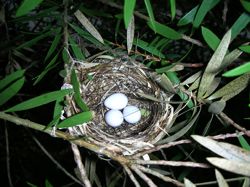
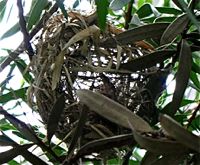
“The eggs could be seen through the thin nest (above right). Building materials were probably hard to find in the rainy season. (It poured heavily just about every day in December 2006 and the first week of January 2007.) The female was probably anxious to lay her eggs as well.
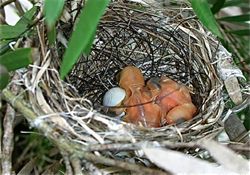
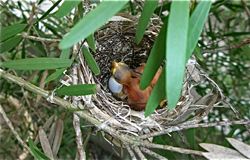
“Two of the three eggs hatched on 17th January.


“The parent birds took turns feeding the chicks. Unlike the parent birds in sunny June who appeared with food within 15mins each time to feed their ravenous young, these monsoon parents took as long as 25mins. These January chicks seemed more laid back too (above). They didn’t ever really stick their necks out and (quietly) scream like the June chicks did (left).
“By 23rd January the two chicks were starting to fill the nest and the nest was looking quite stretched (below). The chicks had grown more adult feathers. One looked more developed than the other. Two mornings later I found the remains of the unhatched egg. The birds had tossed it out. There didn’t seem to be much yolk and no white. The “yolk” I found was rather dense with one tiny but obvious dark spot in it.
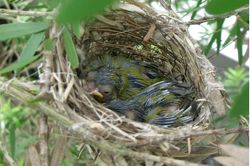
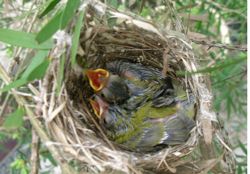
“At around 1pm and exactly eight days after hatching, the bigger of the two chicks flew out of the nest (below). It did not get very far. First, it flew down to a shelf just a metre away. After some coaxing by the very excited parents, it flew back to the tree and stayed there for about half an hour. After that, accompanied by both parents, it flew off into the (nearly) blue yonder. (It didn’t pour that day – it drizzled on and off.)

“A few minutes after the first chick flew, the second chick followed suit. It flew an even shorter distance – barely a third of a metre away from the nest. It then fluttered around to various branches of the tree for the next half hour. (The parents were coaxing both chicks to fly in this frenzied half hour.)
“The parents came back after flying off with the first chick and continued to coax the second into flying off too. They brought bribes. I could see they had things in their beaks which they first showed to the baby before flying off a little distance.
“The second chick refused to budge. The parents gave up after a while and fed it.
“This chick seemed less developed than the June chicks when they started flying. Here’s a comparison… Our monsoon baby is the one on the left and a sunny June chick on the right (below).
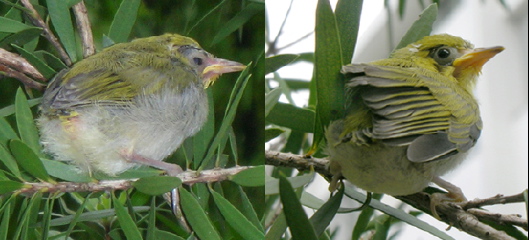
“Here’s another picture of our second chick compared with a June chick (below). The feathers on our monsoon baby’s head aren’t anywhere near as developed as those of the June chicks’.
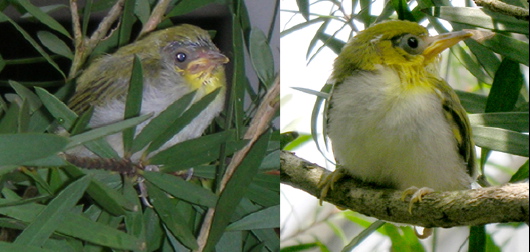
“Poor thing… The second chick was still there at 5:30pm, fluffed up against the wind and drizzle (below). It stayed in the same spot for the next six-and-a-half hours. All that time the parents continued feeding and coaxing it to fly. At one stage, I even saw one of the parents remove something white from its behind. Faecal sac?

“At 7:00pm this baby decided it was ready! It hopped up the highest branch and tried out its wings (below).
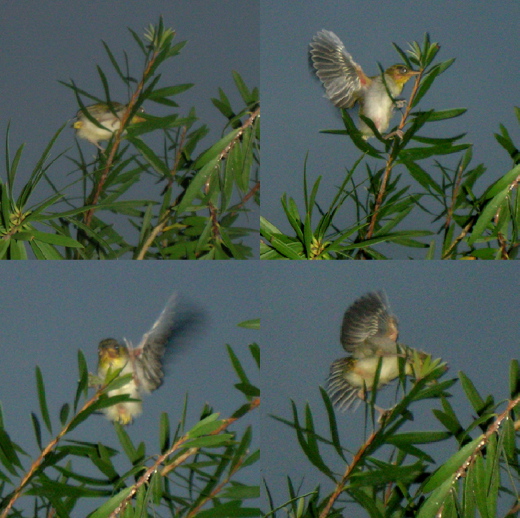
“Then, together with its proud parents, it flew off. Literally into the sunset!
“With the June family, I never saw or heard much from them after they left. With this family, I was still seeing them three days later. (If they are the same birds that is.) One of the birds I saw on 28th January was a young bird, probably one of the babies. (Something tells me it was actually the second chick but I can’t say why I thought that.) It had grown a tail but it’s still more rounded than an adult and slightly fluffy.
“It chirped very loudly and very insistently before flying off after its call was answered by an adult. Tut! Tut! Was it still calling for Mummy and Daddy?”
Input and images by Yen Lau; the above account obtained through the good-office of KC Tsang.
Yen Lau has been twice lucky. She had two families of Oriental White-eyes (Zosterops palpebrosus) nesting in her potted Australian Bottlebrush tree (Callistemon rigidus) – the first family in sunny June and this second in wet Dec/Jan.
According to Yen: “This is what happened with my second white-eye family…
“On 16th Dec 2006 a pair of Oriental White-Eyes were seen inspecting my Australian Bottlebrush trees (left). Seven days later they started building their nest. White cobwebs were wrapped around slender branches about 2 metres or more from the ground. Eleven days later the nest was about ready when they incorporaterd grasses into the nest structure. This continued for the next two days. The nest was very thin but had a nice cup shape to it (below).

“As it was raining every day for the next one week, there were no activities. During a dry patch, one of the white-eyes appeared and sat in the nest. It stayed there all afternoon seemingly not doing anything. I didn’t look at the nest after about 6:30pm and it was still there then. On hindsight, it was probably laying eggs!
“As there had been a bird sitting in the nest constantly the last couple of days, I was sure eggs had been laid. I was skeptical of this at first because the nest was awfully thin. I peeked inside the nest. The bird very obligingly got up and perched on a nearby branch. I was greeted by the sight of 3 beautiful glossy white eggs measuring roughly 6mm X 15mm and snapped a few pictures (below left). The bird then casually hopped back into the nest again. Strange behaviour?


“The eggs could be seen through the thin nest (above right). Building materials were probably hard to find in the rainy season. (It poured heavily just about every day in December 2006 and the first week of January 2007.) The female was probably anxious to lay her eggs as well.


“Two of the three eggs hatched on 17th January.


“The parent birds took turns feeding the chicks. Unlike the parent birds in sunny June who appeared with food within 15mins each time to feed their ravenous young, these monsoon parents took as long as 25mins. These January chicks seemed more laid back too (above). They didn’t ever really stick their necks out and (quietly) scream like the June chicks did (left).
“By 23rd January the two chicks were starting to fill the nest and the nest was looking quite stretched (below). The chicks had grown more adult feathers. One looked more developed than the other. Two mornings later I found the remains of the unhatched egg. The birds had tossed it out. There didn’t seem to be much yolk and no white. The “yolk” I found was rather dense with one tiny but obvious dark spot in it.


“At around 1pm and exactly eight days after hatching, the bigger of the two chicks flew out of the nest (below). It did not get very far. First, it flew down to a shelf just a metre away. After some coaxing by the very excited parents, it flew back to the tree and stayed there for about half an hour. After that, accompanied by both parents, it flew off into the (nearly) blue yonder. (It didn’t pour that day – it drizzled on and off.)

“A few minutes after the first chick flew, the second chick followed suit. It flew an even shorter distance – barely a third of a metre away from the nest. It then fluttered around to various branches of the tree for the next half hour. (The parents were coaxing both chicks to fly in this frenzied half hour.)
“The parents came back after flying off with the first chick and continued to coax the second into flying off too. They brought bribes. I could see they had things in their beaks which they first showed to the baby before flying off a little distance.
“The second chick refused to budge. The parents gave up after a while and fed it.
“This chick seemed less developed than the June chicks when they started flying. Here’s a comparison… Our monsoon baby is the one on the left and a sunny June chick on the right (below).

“Here’s another picture of our second chick compared with a June chick (below). The feathers on our monsoon baby’s head aren’t anywhere near as developed as those of the June chicks’.

“Poor thing… The second chick was still there at 5:30pm, fluffed up against the wind and drizzle (below). It stayed in the same spot for the next six-and-a-half hours. All that time the parents continued feeding and coaxing it to fly. At one stage, I even saw one of the parents remove something white from its behind. Faecal sac?

“At 7:00pm this baby decided it was ready! It hopped up the highest branch and tried out its wings (below).

“Then, together with its proud parents, it flew off. Literally into the sunset!
“With the June family, I never saw or heard much from them after they left. With this family, I was still seeing them three days later. (If they are the same birds that is.) One of the birds I saw on 28th January was a young bird, probably one of the babies. (Something tells me it was actually the second chick but I can’t say why I thought that.) It had grown a tail but it’s still more rounded than an adult and slightly fluffy.
“It chirped very loudly and very insistently before flying off after its call was answered by an adult. Tut! Tut! Was it still calling for Mummy and Daddy?”
Input and images by Yen Lau; the above account obtained through the good-office of KC Tsang.
Saturday, June 15, 2013
Smuggle 24 Putehs into Singapore
He tries to smuggle 24 birds into S'pore in waist pouch
This article was published in The New Paper (Monday, Apr 02, 2012)
This article was published in The New Paper (Monday, Apr 02, 2012)
Malaysian Lim Chia Ming was sentenced to two weeks' jail yesterday for importing two dozen newborn Oriental White-eye birds without a licence from the Agri-Food and Veterinary Authority of Singapore (AVA), reported The Straits Times.
The 55-year-old squeezed each bird into individual tiny boxes tucked into a cloth pouch, which he wore under his clothes throughout the 21/2-hour trip.
Causing distress
On top of the jail term, he was also fined $4,000 for causing distress to the hatchlings by keeping them in the small boxes, which measured 7.5cm by 2.5cm by 2.5cm - slightly larger than a matchbox.
Lim pleaded guilty to both offences.
The court heard that he was visiting his girlfriend in Batam last Friday when he visited a bird shop there.
He then informed the Indonesian owner of his intention to smuggle the birds.
The owner sold 24 birds to Lim and passed him 24 perforated boxes.
Lim used a borrowed cage to transport the birds to his girlfriend's house.
At 7am the following day, the owner met Lim at the house to assist with the packing of the birds, also known as mata puteh in Malay.
At about 9.30am, when Lim reached Singapore, he was caught by Immigration and Checkpoints Authority officers during a routine check at the Singapore Cruise Centre.
The AVA bans the import of birds from Highly Pathogenic Avian Influenza-affected countries like Indonesia to safeguard Singapore against the introduction of animal diseases.
The Oriental White-Eye is popular with bird lovers. Hatchlings are commonly sold for $250.
While it remains unknown how much Lim paid for the birds in Batam, bird lovers here suggested that prices might start from $2.
Putehs on MRT train.
No pets or animals, except guide dogs, are allowed on trains.
Despite a fine of up to $500, commuters have been spotted bringing dogs, cats and birds onto MRT trains.
Despite a fine of up to $500, commuters have been spotted bringing dogs, cats and birds onto MRT trains.
Tuesday, June 11, 2013
Monday, June 10, 2013
Saturday, June 8, 2013
Wednesday, June 5, 2013
Saturday, June 1, 2013
Tuesday, May 28, 2013
Popular cage bird in Singapore and Malaysia
Mata Puteh (Oriental White-eyes)
The most popular cage bird in Singapore and Malaysia is the Oriental White-eye. The Oriental White-eye is also known as Mata Puteh (i.e. “white eye”) in Malaysia and Singapore. This name is derived from the ring of white around the eyes which thicken as the bird gets older. It is not unusual to find 100 to 200 Oriental White-eyes at each of the more popular gathering places in in Singapore on Sundays.
Any experienced birdwatcher will tell you that the
Most of us will feed our Putehs with commercial pellets and supplement it with fresh fruits. The question is whether we are giving the Puteh too much fruits. The answer is simply: No.

An animal such as a bird (or any other animal except Carp) eats only what is necessary and never over eat. So you may stick a whole apple or orange inside the cage, but the Puteh will not gorge itself to death, instead it will peck only a small portion of it. The only harm is that it’s a waste to put an entire orange or apple in the cage. If anyone tells you that his Mata Puteh ate an entire apple in one day - it’s either he is joking or he is delusional.
Join Mata Puteh Community On FaceBook
Enjoy your hobby, cheers!
The most popular cage bird in Singapore and Malaysia is the Oriental White-eye. The Oriental White-eye is also known as Mata Puteh (i.e. “white eye”) in Malaysia and Singapore. This name is derived from the ring of white around the eyes which thicken as the bird gets older. It is not unusual to find 100 to 200 Oriental White-eyes at each of the more popular gathering places in in Singapore on Sundays.
The cages for these birds are very small and each owner can comfortably carry 2 to 6 birds. Canvas bags can even be purchased for the specific purpose of carrying cages for these birds. These bags look very much like large shopping bags with each bag being able to hold up to 3 cages. This enables the more enthusiastic hobbyist to personally transport 6 cages at a time with the help of 2 of these bags, one bag in each hand.
I believe that most forumers would agree with the logic that as bird keepers or even if you are keeping other animals (dogs, cats, fish etc) you would try to provide the animal with food which is its natural diet. Of course now we have dog biscuits for dogs, cat food for cats and so on. But even such commercial preparations always advertise themselves that the ingredients are very close to natural food.
The same applies to birds. Why do people take the trouble to catch grasshoppers or pay for crickets which are troublesome noisy insects, to feed their birds? Again it’s simply that we wish to feed our birds with the closest substitute to their natural diet.
Any experienced birdwatcher will tell you that the
Mata Puteh's natural diet consists mainly of four things: nectar, fruits, grubs (and small caterpillars) and small insects (including small spiders).
Most of us will feed our Putehs with commercial pellets and supplement it with fresh fruits. The question is whether we are giving the Puteh too much fruits. The answer is simply: No.

An animal such as a bird (or any other animal except Carp) eats only what is necessary and never over eat. So you may stick a whole apple or orange inside the cage, but the Puteh will not gorge itself to death, instead it will peck only a small portion of it. The only harm is that it’s a waste to put an entire orange or apple in the cage. If anyone tells you that his Mata Puteh ate an entire apple in one day - it’s either he is joking or he is delusional.
Join Mata Puteh Community On FaceBook
Enjoy your hobby, cheers!
Friday, May 24, 2013
Keeping Puteh For Pleasure Of Listening To Their Songs
Pleasure Of Listening To Puteh Birdsong
Most of the suggestions and postings made here are meant for anyone who wished to maintain his Puteh in good health and hence in good form. This will ensure that your Puteh will be in form but by no means will you be guaranteed a "Champion bird' or even a second and third placing.
All over the world, people keep songbirds for the pleasure of listening to their songs. In the east, such a hobby is taken a little bit further, and enjoyed like an art. Actually it is a combination of both art and science. Hence over here, we had cultivated the taste to appreciate birds in a certain way which can be very strange to westerners or new comers to the hobby (but once they have acquired that taste, it will be like getting bitten by a bird bug that will remain with them for the rest of their lives).
To begin with, we must listen and learn what kind of songs is most pleasurable to our ears. Next we must have the eye for a good bird - in the case of the puteh, the way they stand, their physique, their movements etc. Then we must have the patience and know-how to train and nurture it to be close to a stage of perfection vocally and appearance wise. Finally, the way they are being presented in public - the beautiful cages and accessories most suitable to compliment the species of bird.
So as you can see, the serious hobbyist in this part of the world don't just walk into a shop, ask for a Puteh, throw it into a cage, hang it up and say, "a Puteh is a Zosterops and it can sing".....
Ok, now how a bird should sound like, how it should move about, how it should carry itself etc., the guidelines are not set overnight because someone fancy it to be so. Most of these are in some ways, interpretations of the bird in its natural state during the period when it is at its peak. For example: The aggressive territorial songs, the aggressive stance and the displays of a Puteh.
These guidelines are also used in judging birds in the competitions - certain number of points awarded for song, certain points for loudness, certain points for 'play' etc. etc. Some movements are deemed undesirable perhaps because they don't coincide with the smooth flow of the bird in full display or 'play'. Example: if during the middle of an aggressive territorial display of the Puteh, it suddenly stops and twist its head in a very awkward way, how would it look like to you? This is also not in any way the natural movements of a normal Puteh in the wild. Such movements are obviously very undesirable when presenting your bird in a competition or in public ““Chai”” places. Hobbyists refer to these undesirable movements like bad habits in movements.
Putehs, jumping from the perch to under the roof and back again onto the perch (if that is what you meant by somersault) - can this be considered a bad habit? It all depends on how people interpreted this movement - whether it is deemed to be a natural part of the 'play' or whether it is considered as a distraction from the normal 'play' of the bird. Some do and some don't. During those days when Putehs are plentiful, some hobbyists will discard birds with the slightest of 'imperfection' and such movements then could be a little more undesirable than now. Guidelines and interpretations do change because of circumstances. In these days when birds are hard to come by, not many will regard this as an 'imperfection'.
Join Mata Puteh Community On FaceBook
Enjoy your hobby. Cheers!
Most of the suggestions and postings made here are meant for anyone who wished to maintain his Puteh in good health and hence in good form. This will ensure that your Puteh will be in form but by no means will you be guaranteed a "Champion bird' or even a second and third placing.
All over the world, people keep songbirds for the pleasure of listening to their songs. In the east, such a hobby is taken a little bit further, and enjoyed like an art. Actually it is a combination of both art and science. Hence over here, we had cultivated the taste to appreciate birds in a certain way which can be very strange to westerners or new comers to the hobby (but once they have acquired that taste, it will be like getting bitten by a bird bug that will remain with them for the rest of their lives).
To begin with, we must listen and learn what kind of songs is most pleasurable to our ears. Next we must have the eye for a good bird - in the case of the puteh, the way they stand, their physique, their movements etc. Then we must have the patience and know-how to train and nurture it to be close to a stage of perfection vocally and appearance wise. Finally, the way they are being presented in public - the beautiful cages and accessories most suitable to compliment the species of bird.
So as you can see, the serious hobbyist in this part of the world don't just walk into a shop, ask for a Puteh, throw it into a cage, hang it up and say, "a Puteh is a Zosterops and it can sing".....
Ok, now how a bird should sound like, how it should move about, how it should carry itself etc., the guidelines are not set overnight because someone fancy it to be so. Most of these are in some ways, interpretations of the bird in its natural state during the period when it is at its peak. For example: The aggressive territorial songs, the aggressive stance and the displays of a Puteh.
These guidelines are also used in judging birds in the competitions - certain number of points awarded for song, certain points for loudness, certain points for 'play' etc. etc. Some movements are deemed undesirable perhaps because they don't coincide with the smooth flow of the bird in full display or 'play'. Example: if during the middle of an aggressive territorial display of the Puteh, it suddenly stops and twist its head in a very awkward way, how would it look like to you? This is also not in any way the natural movements of a normal Puteh in the wild. Such movements are obviously very undesirable when presenting your bird in a competition or in public ““Chai”” places. Hobbyists refer to these undesirable movements like bad habits in movements.
Putehs, jumping from the perch to under the roof and back again onto the perch (if that is what you meant by somersault) - can this be considered a bad habit? It all depends on how people interpreted this movement - whether it is deemed to be a natural part of the 'play' or whether it is considered as a distraction from the normal 'play' of the bird. Some do and some don't. During those days when Putehs are plentiful, some hobbyists will discard birds with the slightest of 'imperfection' and such movements then could be a little more undesirable than now. Guidelines and interpretations do change because of circumstances. In these days when birds are hard to come by, not many will regard this as an 'imperfection'.
Join Mata Puteh Community On FaceBook
Enjoy your hobby. Cheers!
Tuesday, May 21, 2013
Intro To Mata Puteh
Mata Puteh
The Oriental White-eye (Zosterops palpebrosus) is a small pas-serine bird in the white-eye family. It is a resident breeder in open woodland in tropical Asia, east from the Indian Subcontinent to Southeast Asia, extending to Indonesia and Malaysia. They forage in small groups, feeding on nectar and small insects. They are easily identified by the distinctive white eye-ring and overall yellowish upper parts. Several populations of this widespread species are named subspecies and some have distinctive variations in the extent and shades of yellows in their plumage.
This bird is small (about 8–9 cm long) with yellowish olive upper parts, a white eye ring, yellow throat and vent. The belly is whitish grey but may have yellow in some subspecies. The sexes look similar. The species is widespread and is part of a super species complex that includes Zosterops japonicus, Zosterops meyeni and possibly others. The taxonomy of the group is still unclear with some island populations being distinctive while some subspecies are not well supported. The population from Flores, Indonesia for instance is found closer to the Pale White-eye. The family itself is now questioned since they are nested along with the Stachyris babblers.
About eleven subspecies are well recognized. These include the nominate form (type locality Bengal, India) which is found from Oman and Arabia, Afghanistan, northern India and extends into China and northern Myanmar. The population in the Western Ghats and hills of southern India is placed in nilgiriensis while salimalii of the Eastern Ghats hills (Shevaroy, Chitteri, Seshachalam, Nallamalai) is sometimes subsumed into the nominate race. The population of the plains of India, Laccadives and Sri Lanka are sometimes placed in egregius (= egregia) but is restricted by other works to the population in Sri Lanka. The populations in southern Myanmar, Thailand and Laos are placed in siamensis. The Nicobar Islands form is nicobaricusand is sometimes also used for the population on the Andaman Islands which are however distinctive and a distinct unnamed population. The populations from southern Thailand to western Cambodia are placed in williamsoni. Other Southeast Asian island forms includeauriventer (=aureiventer), buxtoni, melanurus and unicus.
Race occidentis (now often subsumed into the nominate race) of the Western Himalayas has the upper side dark green and the flanks are tinged in brown. The form salimalii has a shorter bill and is brighter yellow-green above. Some authors consider the nominate race to be restricted to Sikkim, Bhutan, Assam and Yunnan and consider the peninsular race asoccidentis (or amabilis if the form from Kathiawar described by Koelz is considered valid).
In Sri Lanka, race egregia is smaller and has a brighter back and throat than the endemic Sri Lanka White-eye, Zosterops ceylonensis found in the central hills.
The English and scientific names refer to the conspicuous ring of white feathers round the eyes, zosterops being Greek for 'girdle-eye'.
Distribution and habitat
The species is found in a wide range of habitats from scrub to moist forest. They sometimes occur on mangrove areas such as in theKarachi area and on islands they may lead a more insectivorous life. They are somewhat rare only in the drier desert regions of western India.
A feral population was detected in San Diego, California in the 1980s and subsequently eradicated.
Behavior and ecology
These white-eyes are sociable, forming flocks which only separate on the approach of the breeding season. They are highly arboreal and only rarely descend to the ground. The breeding season is February to September but April is the peak breeding season and the compact cup nest is a placed like a hammock on the fork of a branch. The nest is made of cobwebs, lichens and plant fiber. The nest is built in about 4 days and the two pale blue eggs are laid within a couple of days of each other. The eggs hatch in about 10 days. Both sexes take care of brooding the chicks which fledge in about 10 days. Though mainly insectivorous, the Oriental White-eye will also eat nectar and fruits of various kinds.
They call frequently as they forage and the usual contact call is a soft nasal cheer. They pollinate flower when they visit them for flower insects (such as thrips) and possibly nectar (questioned) that form their diet. The forehead is sometimes coloured by pollen leading to mistaken identifications. They have been observed bathing in dew accumulated on leaves.
When nesting, they may mob palm squirrels but being small birds they are usually on the defensive. Their predators include bats (esp. Megaderma lyra) and birds such as the White-throated Kingfisher. Endoparasitic Haemosporidia of the genus Haemoproteus and Dorisa have been isolated from the species although these rarely cause death.
Like some other white-eyes, they sometimes steal nest material from the nests of other birds. Cases of interspecific feeding have been noted with white-eyes feeding the chicks of a Paradise Flycatcher.
Although not strong fliers, they are capable of dispersing in winds and storms to new areas including offshore islands. A feral population of this species established itself in California during the 1980s requiring their capture and destruction. They were captured by luring them using call playback and live decoys into mistnets.
From Wikipedia, the free encyclopedia.
Subscribe to:
Posts (Atom)











